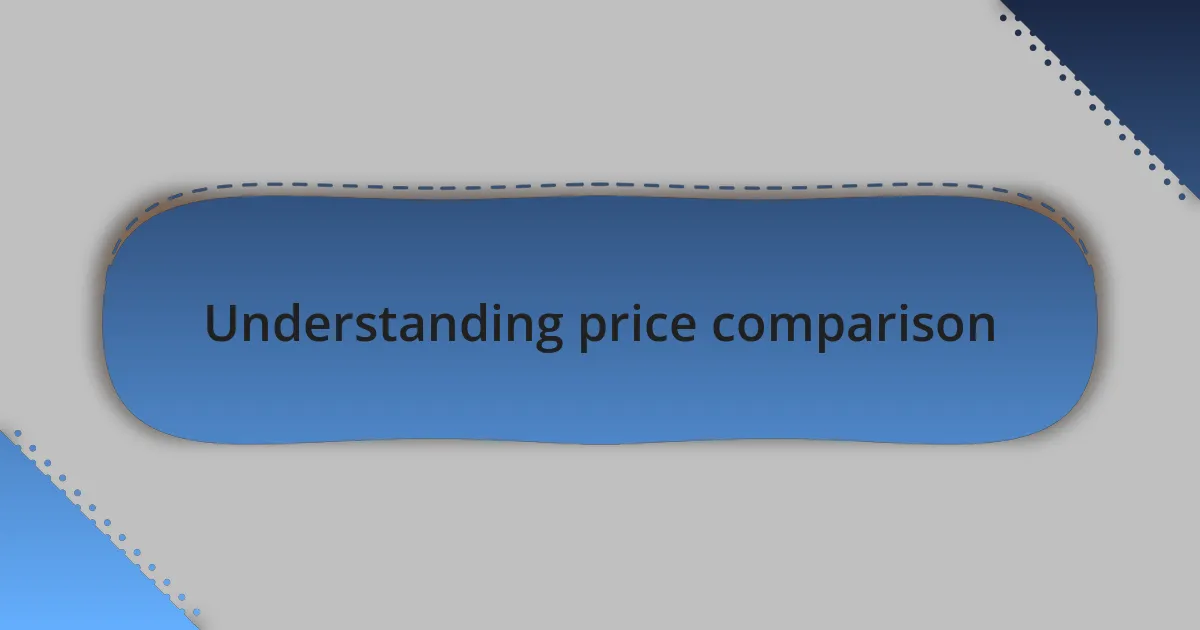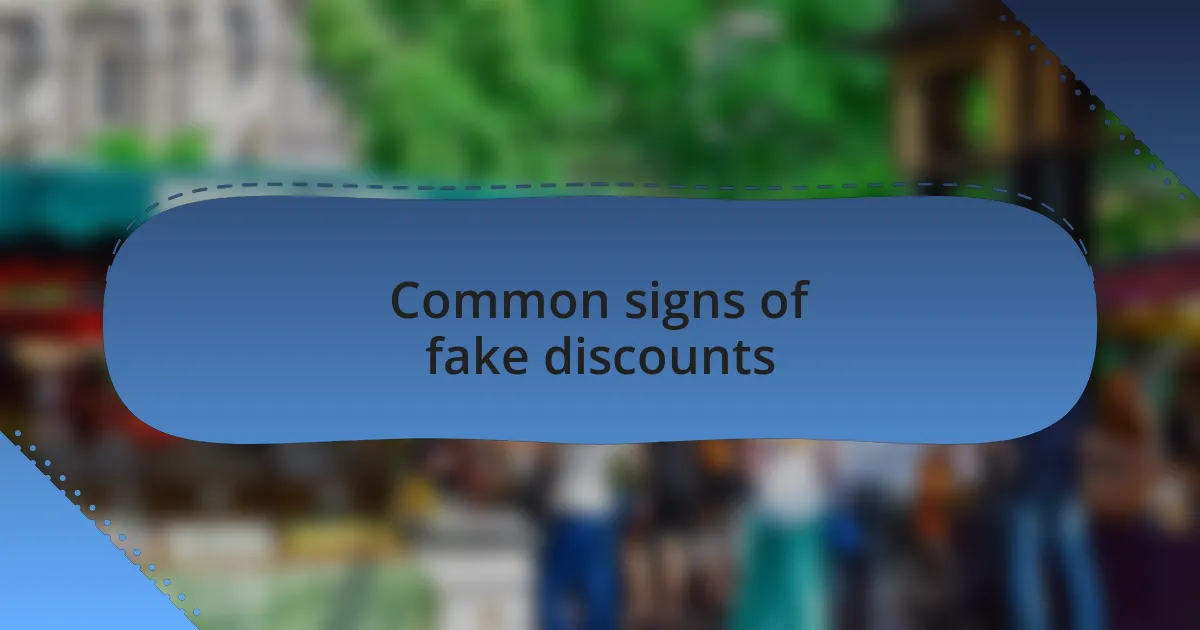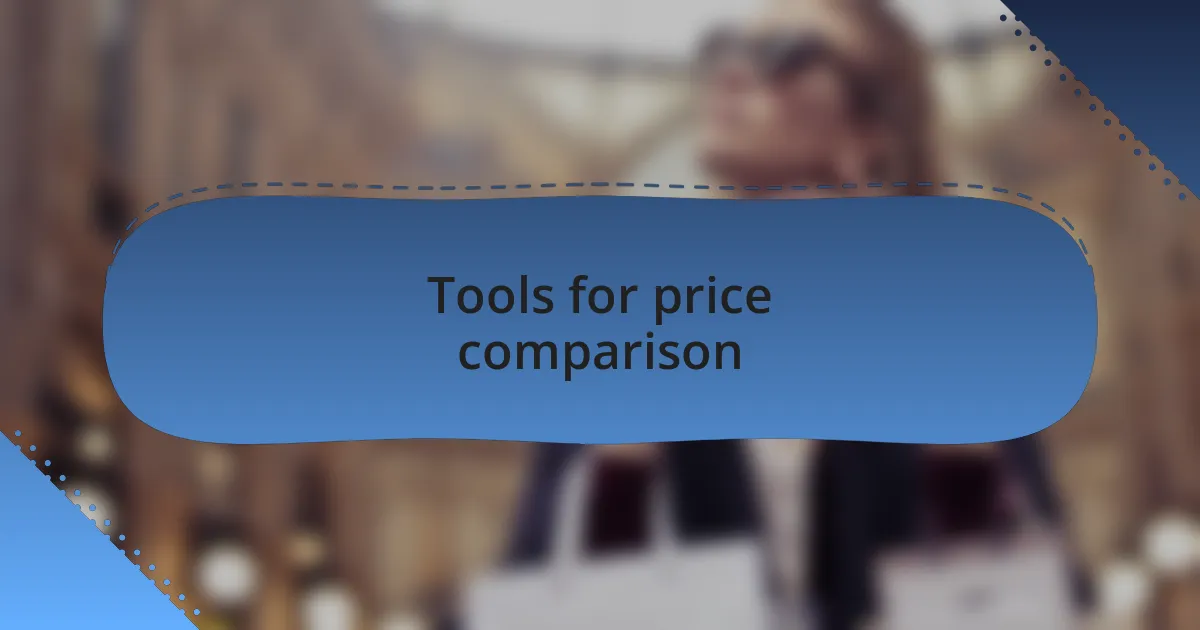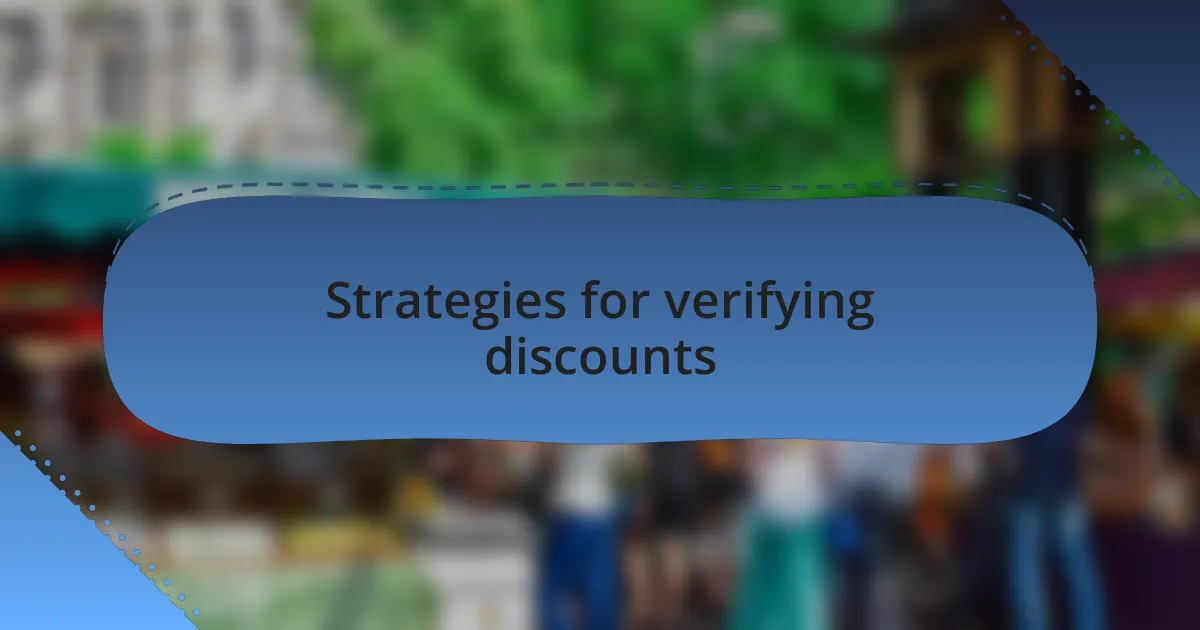Key takeaways:
- Price comparison is essential for making informed purchasing decisions, helping consumers identify genuine discounts and avoid marketing gimmicks.
- Common signs of fake discounts include unclear original pricing, aggressive marketing tactics, and inconsistencies in discount labels.
- Utilizing tools like price comparison websites, browser extensions, and social media can enhance the shopping experience and reveal better deals.
- Researching price history and understanding the fine print of discounts are crucial strategies for verifying the authenticity of sales.

Understanding price comparison
Price comparison plays a crucial role in helping consumers make informed decisions. I often find myself browsing different websites, searching for the best deals before making a purchase. It’s fascinating how a few clicks can reveal the stark difference in prices for the same product across various retailers.
Often, I ask myself: what truly drives those price variations? Is it a temporary sale, or are some sites just inflating their regular prices to create an illusion of savings? This thought process has deepened my understanding of pricing strategies. It’s important to dig deeper—not only do you compare prices, but you also need to evaluate the credibility of the discounts offered.
Having experienced the frustration of discovering a “discount” that was, in fact, a marketing gimmick, I’ve learned to look beyond the surface. My instincts tell me that if a deal seems too good to be true, it probably is. I’ve come to rely on price comparison as a valuable tool, ensuring that I am not just chasing what looks inexpensive, but what actually represents a real-saving opportunity.

Importance of identifying discounts
Identifying genuine discounts can save consumers significant money, but it’s not always straightforward. I remember when I once snagged what I thought was a phenomenal deal on shoes, only to realize later that the original price had been artificially inflated. It left me feeling a bit tricked and more determined than ever to scrutinize discounts before pulling the trigger on a purchase.
Another time, I noticed a popular electronics store advertising a huge discount on a laptop I had been eyeing. Curious about the real value, I compared the price across several platforms. It was eye-opening to see how that “great deal” was, in fact, not much different from the regular price elsewhere—frustrating, yet enlightening, illustrating just how important it is to be vigilant when evaluating discounts.
Recognizing the importance of identifying fake discounts makes for smarter shopping decisions. I often ponder: how many others have fallen for similar traps? By sharing my experiences and insights, I hope to empower fellow shoppers to question deals and really understand the prices they encounter, enabling them to shop confidently and avoid costly mistakes.

Common signs of fake discounts
When browsing for deals, one red flag that often stands out is the absence of clear original pricing. I recall finding a stunning dress at a supposed 50% discount, but the website lacked any historical pricing data. It made me wonder if that discount was just an illusion—how often does that happen to others who may not dig deeper into the store’s pricing history?
Another clue that a discount might be fake is overly aggressive marketing language. I remember seeing an ad proclaiming an “EXTRA 70% OFF” only to discover it was applied to a limited selection of items, most of which were out of stock. It left me feeling frustrated and misled. Why do companies feel the need to exaggerate? A genuine discount should feel transparent, not like a high-pressure sales tactic.
Pay attention to inconsistencies in the discount label itself. One time, I encountered a product labeled at two different discount prices on the same website, leaving me questioning which was real. This inconsistency bred skepticism in me: if they can’t even get their pricing straight, can I trust their discounts? It’s essential to remain vigilant, trusting your instincts when something just doesn’t add up.

Tools for price comparison
When it comes to tools for price comparison, I often find myself relying on dedicated websites and browser extensions that simplify the process. Recently, I discovered a handy extension that alerts me when a product’s price drops, which saved me from purchasing an item at a higher price. Isn’t it satisfying to know you got the best deal?
Mobile apps are also a game-changer. I remember using one that scanned barcodes while I was shopping in-store. It not only helped me compare prices across various retailers but also flagged any ongoing sales. Has this ever happened to you—finding a better price just a few aisles over? It truly emphasized how smart shopping can be in the digital age.
Another effective tool I’ve utilized is social media pages that curate deals. A while back, I stumbled upon a Facebook group where members shared their finds and price drops in real-time. Engaging in that community gave me insights into trends I might have missed otherwise. Have you ever felt that thrill when you snag a deal right before everyone else? It’s these tools that make price comparison not just smart, but fun.

How to research product prices
Researching product prices is a mix of strategy and intuition for me. I often start by checking multiple online retailers to see how they compare, but I can’t overlook user reviews that mention pricing history. Just the other day, I was torn between two electronics, and a quick search revealed that one model was frequently discounted, making it a smart buy. Have you ever found yourself surprised by how often prices fluctuate?
Another method I rely on is keeping track of price history using specific websites. There’s something quite reassuring about seeing a graph that shows how prices have changed over time. I remember a time when I was about to purchase a popular gadget, but reviewing its price trend helped me hold out for a meaner discount. That moment made me wonder—how many good deals have I missed simply because I didn’t do my homework?
Lastly, I often utilize newsletters and alerts from retailers. They offer insights into upcoming sales and exclusive discounts. Just last week, I received a notification about an item I was monitoring, and it dropped by a whopping 30% overnight! When was the last time you caught a deal like that? It’s all about being proactive and making that extra effort to stay informed.

Strategies for verifying discounts
One strategy I find invaluable is comparing discounts across different retailers before making a purchase. I recall browsing for a new winter coat and noticing two stores offering the same jacket at a “sale” price. However, after diving deeper, I discovered that one retailer had inflated the original price prior to the sale, making their discount less impressive. Have you ever stumbled upon such a situation that made you rethink your choices?
Another effective technique is to read the fine print on discount claims. A few months back, I almost bought a kitchen appliance advertised as 50% off, but the deal only applied to a limited selection of models. It’s crucial to understand the details—those little notes can really impact whether you’re getting a genuine bargain or just a cleverly disguised marketing tactic. How often do you scrutinize the terms behind those flashy discount signs?
Lastly, I often leverage social media and deal forums where shoppers share their experiences. One time, a friend pointed out a popular device that was frequently touted as ‘on sale’. After checking the community discussions, I learned it was rarely offered at its original price, which made me reconsider my impulsive urge to buy. It’s fascinating how collective wisdom can help us spot fake discounts and snag true savings. How do you tap into the community wisdom surrounding your shopping habits?

Personal experience with discount verification
When it comes to discount verification, I always remember the time I almost purchased a pair of sneakers that boasted a remarkable 40% off. I took a moment to check a reliable price comparison site and found that the original price was actually misleading. It reminded me that a discount is only as good as its context—what seems like a great deal could just be clever marketing at work. How often do we stop to question the authenticity of the savings presented to us?
I’ve also learned the importance of tracking prices over time. Recently, I was eyeing a gadget that had its price slashed during a seasonal sale. However, I recalled watching it slowly decrease in price over several months. It turns out, in this case, the discount was nothing more than an annual marketing strategy dressed up in urgency. Reflecting on this has made me more cautious about rushing into purchases based on “limited-time” offers. Have you ever tracked a product’s price and found it fluctuating wildly?
Another eye-opener was the day I interacted directly with customer service about a so-called “deal” that didn’t add up. They were incredibly helpful, recognizing I wasn’t the only one confused by the discount. This communication reminded me that asking questions can sometimes bring not only clarity but also unexpected revelations that save us money. Have you ever directly asked for transparency regarding a sale? You might be surprised at what you uncover.